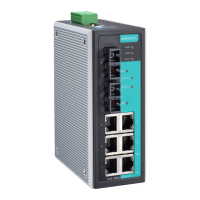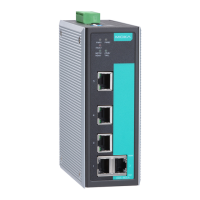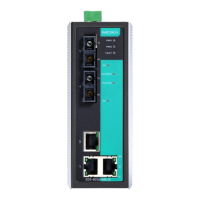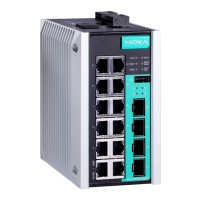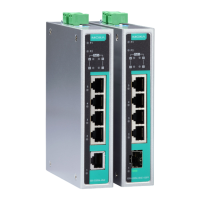Moxa Managed Ethernet Switch (UI_2.0_FW_5.x) User Manual
QoS
The Moxa switch’s traf f ic prioritization capability provides Quality of Service (QoS) to your network by
making data delivery more reliable. You can prioritize traf f ic on your network to ensure that high priority
data is transmitted with minimum delay. Traf f ic can be controlled by a set of rules to obtain the required
Quality of Service for your network. The rules define different types of traffic and specify how each type
should be treated as it passes through the switch. The Moxa switch can inspect both IEEE 802.1p/1Q layer 2
CoS tags, and even layer 3 TOS information to provide consistent classification of the entire network. The
Moxa switch’s QoS capability improves the perf ormance and determinism of industrial networks f or mission-
critical applications.
There are two types of QoS settings, depending on which model of switch you are using.
Type 1
EDS-510E, EDS-518E, EDS-528E, EDS-G512E-8PoE, EDS-G508E, EDS-G512E-4GSFP,
EDS-G516E-4GSFP, IKS-6726A, IKS-6728A, IKS-6728A-8PoE
Type 2
IKS-G6524A, IKS-G6824A, ICS-G7526A, ICS-G7826A, ICS-G7528A, ICS-G7828A, ICS-
G7748A, ICS-G7848A, ICS-G7750A, ICS-G7850A, ICS-G7752A, ICS-G7852A
The Traffic Prioritization Concept
Traffic prioritization allows you to prioritize data so that time-sensitive and system-critical data can be
transf erred smoothly and with minimal delay over a network. The benef its of using traf f ic prioritization are:
• Improve network performance by controlling a wide variety of traf f ic and by managing congestion.
• Assign priorities to dif f erent categories of traf f ic. For example, set higher priorities f or time-critical or
business-critical applications.
• Provide predictable throughput for multimedia applications, such as video conferencing or voice over IP,
and minimize traf f ic delay and jitter.
• Improve network performance as the amount of traffic grows. Doing so will reduce costs since it will not
be necessary to keep adding bandwidth to the network.
Traf f ic prioritization uses the f our traf f ic queues that are present in your Moxa switch to ensure that high
priority traf f ic is f orwarded on a dif f erent queue f rom lower priority traf f ic. Traf f ic prioritization provides
Quality of Service (QoS) to your network.
Moxa switch traf f ic prioritization depends on two industry-standard methods:
• IEEE 802.1D—a layer 2 marking scheme.
• Differentiated Services (DiffServ)—a layer 3 marking scheme.
IEEE 802.1D Traffic Marking
The IEEE Std 802.1D, 1998 Edition marking scheme, which is an enhancement to IEEE Std 802.1D, enables
Quality of Service on the LAN. Traffic service levels are defined in the IEEE 802.1Q 4-byte tag, which is used
to carry VLAN identif ication as well as IEEE 802.1p priority inf ormation. The 4-byte tag immediately f ollows
the destination MAC address and Source MAC address.
The IEEE Std 802.1D, 1998 Edition priority marking scheme assigns an IEEE 802.1p priority level between 0
and 7 to each frame. The priority marking scheme determines the level of service that this type of traf f ic
should receive. Refer to the table below for an example of how different traffic types can be mapped to the
eight IEEE 802.1p priority levels.
IEEE 802.1p Priority Level
3 Excellent Ef f ort (business critical)
Controlled Load (streaming multimedia)
Video (interactive media); less than 100 milliseconds of latency and jitter
Voice (interactive voice); less than 10 milliseconds of latency and jitter
Network Control Reserved traffic

